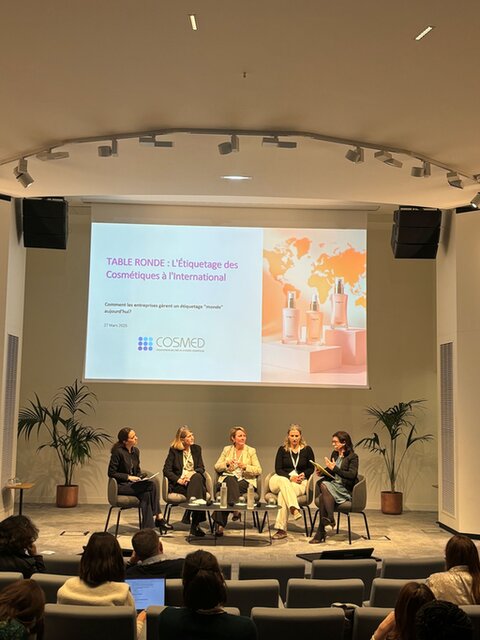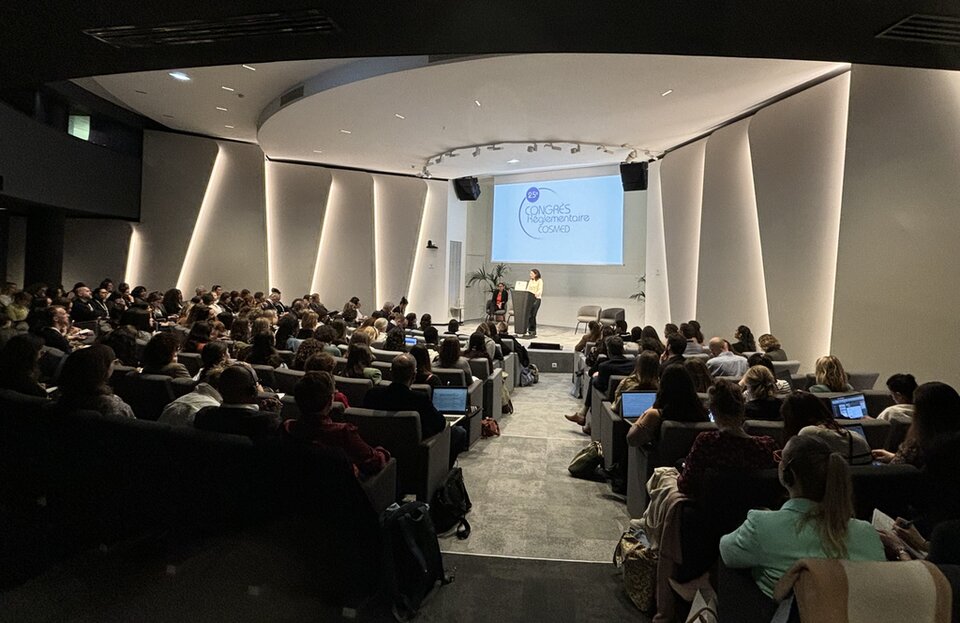REPORT
Insights from cosmed regulatory congress – get ready for 2025 & beyond
On 26–27 March 2025, COSMED brought together more than 400 cosmetic regulators, industry experts, and compliance specialists for its annual Regulatory Congress in Paris. Over these two days, more than a dozen sessions addressed the fast-evolving landscape of cosmetic legislation, from EU reforms to country-specific evolutions. Below is a report on the key moments and a look ahead at what 2025 will bring.


Day 1: Europe’s regulatory framework
The first day offered participants an overview of the most significant current and upcoming regulatory developments within the European Union. The presentations that captured the most attention were those delivered by French and European authorities, along with the session dedicated to the Packaging and Packaging Waste Regulation (PPWR).
Attendees also benefited from expert-led conferences covering the impacts of the CLP Regulation reform, the forthcoming Digital Product Passport, and the day ended in a lively roundtable discussion on microplastics regulation and practical implementation.
During its inspection campaigns, the French authority DGCCRF evaluated the compliance of cosmetic operators concerning Product Information Files (PIF). Among the 147 establishments inspected, nearly 90% presented one or more non-conformities, such as absent, incomplete, or outdated PIFs, unavailability of documentation, and deficiencies in safety reports. The DGCCRF has announced that PIF compliance will remain a priority in 2025 inspections, particularly targeting service providers.
Regarding Good Manufacturing Practices (GMP), the DGCCRF aims to harmonize inspection practices and is collaborating with industry representatives to develop clearer standards to support and guide industry on how to properly implement GMPs.
These results and actions underline the critical need for ongoing dialogue between regulatory bodies and industry stakeholders. COSMED announced the reinforcement of its support to the sector through new working groups and practical tools, helping cosmetic companies to ensure both regulatory compliance and competitiveness on the market.
DG GROW, the Directorate-General for Internal Market, Industry, Entrepreneurship, and SMEs of the European Commission, is actively advancing regulatory initiatives in the cosmetics sector. Current priorities include updates to the EU ingredient glossary and the adoption of the VII and VIII "Omnibus" regulations, aimed at banning or restricting substances classified as carcinogenic, mutagenic, or reprotoxic (CMR).
Looking ahead, DG GROW is preparing evaluations and potential updates to key frameworks such as the Cosmetics Products Regulation (CPR), sunscreen efficacy recommendations, definitions of nanomaterials, and CMR guidelines.
The last item presented, the JACOP joint action planned for 2025, will focus on market surveillance activities, particularly verifying the absence of prohibited substances and the accuracy of SPF claims.
In these ongoing efforts to streamline regulations, COSMED participates in working groups and responds to consultations with the aim of supporting cosmetic companies.
Regarding the European Packaging and Packaging Waste Regulation (PPWR), a practical presentation highlighted its significant implications for the cosmetics industry. The PPWR’s key objectives are to reduce packaging waste, promote reuse, ensure all packaging is recyclable, and increase the use of recycled materials. For cosmetic brands, this will necessitate substantial changes in packaging design, including enhanced recyclability, minimized material usage, and the incorporation of recycled content, all of which could impact product performance and logistics.
Some packaging types (multi-constituent or multilayer), product types (small products such as lipsticks), or substances (carbon black, silicones) pose very difficult challenges for now, and the industry should mobilize its resources to address them. Consumer engagement must also be considered in terms of sorting and active participation in recycling.
However, the PPWR also offers opportunities for innovation and brand reputation through sustainable packaging strategies.

Day 2: Global market access, country focus & worldwide panorama
The second day of the congress focused on international regulations, offering updates on key developments in three major markets for the cosmetics industry: China, South Korea, and the United States.
The presentation about China offered key insights first into the regulatory landscape on full safety assessment effective after May 1, 2025. Safety evidence requirements for ingredients include three-year usage history, authoritative international safety evaluations (such as SCCS or CIR reports), and Chinese market data, to avoid the need for conducting or providing toxicity tests on each ingredient. The challenges in assessing the safety of plant extracts and other complex substances, particularly in the context of animal testing bans and limited toxicity data, were also highlighted.
Additionally, new GMP regulations under the Cosmetic Supervision and Administration Regulation (CSAR) have been in force since July 1, 2022, setting requirements for cosmetic registrants, filers, and contract manufacturers, including the qualifications of responsible quality and safety personnel. The NMPA has intensified its inspection regime, both domestically and internationally, with common non-compliances such as deviations from registered formulations, inadequate product release procedures, and deficient quality systems.
For Korea, the regulatory framework governing cosmetics was explained, along with key requirements for cosmetic products such as the import process, required documentation, and compliance measures.
As for the latest developments, revisions to the Enforcement Rules of the Cosmetic Act introduced more flexibility on labelling requirements for batch numbers and expiration dates or period-after-opening (PAO) on packs containing several products.
Additionally, it was announced that the Ministry of Food and Drug Safety (MFDS) has planned a phased roadmap for the implementation of a cosmetic safety assessment. The implementation is expected to begin gradually from 2028, with full compliance expected across all companies and product types by 2031.
The presentation on the United States provided by IBA (Independent Beauty Association) offered an overview of the evolving regulatory environment.
It particularly highlighted the ongoing complexities between federal and state-level regulations, stressing the significant number of state-level regulatory initiatives, for example, proposals in California targeting restrictions on musk chemicals in cosmetics or in Connecticut setting a phased reduction of 1,4-Dioxane traces…
After a brief update on the MoCRA, recent leadership changes within the U.S. Food and Drug Administration (FDA) were discussed, underlining the uncertainty such changes create and their potential impact on regulatory policies and enforcement.
The rest of the day was dedicated to worldwide overviews, including presentations on controversial ingredients, global chemical inventories and their impact on cosmetics, as well as evolving environmental regulations. A roundtable also addressed challenges in product labelling requirements for cosmetics exported worldwide, highlighting the growing complexity brands must navigate to remain compliant in international markets.
Conclusion
COSMED Regulatory Congress 2025 confirmed that global cosmetic regulations are entering an era of increased scrutiny, environmental consciousness, and higher consumer expectations. Staying compliant will require a proactive, agile, and innovation-driven approach across all levels of the supply chain. Besides, industry collaboration and active participation in consultations and working groups will be vital.
Calendars are marked for next year Congress (already set on 1st and 2nd April 2026), which promises to deliver even deeper insights and practical guidance for navigating this complex and fast-moving landscape.
Marie MAGNAN
Regulatory Affairs Manager, COSMED
References and notes
- Karković Marković, A.; Torić, J.; Barbarić, M.; Jakobušić Brala, C. Hydroxytyrosol, Tyrosol and Derivatives and Their Potential Effects on Human Health. Molecules 2019, 24, 2001. https://doi.org/10.3390/molecules24102001
- Nunes, A., Marto, J., Gonçalves, L., Martins, A.M., Fraga, C. and Ribeiro, H.M. (2022), Potential therapeutic of olive oil industry by-products in skin health: a review. Int. J. Food Sci. Technol., 57: 173-187. https://doi.org/10.1111/ijfs.15384